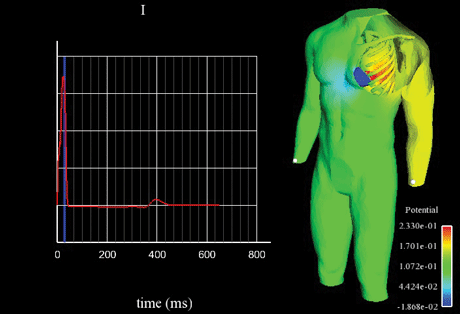by Marc Thiriet
The ERCIM Working Group 'IT and Mathematics applied to Interventional Medicine' (IM2IM) held its annual meeting in Lausanne, Switzerland on 14-15 May. The meeting was held during the ERCIM spring meetings and the SARIT'07 symposium on the topic 'Computing for Health' which focused on the Virtual Physiological Human.
The working group (WG) meeting had two sessions: the first on Monday 14 May with presentations from the WG members, and the second dedicated to discussions on possible proposals under the 7th Framework Programme.
The first talk of the presentation session was given by Muriel Boulakia from the INRIA REO (numerical simulation of biological flows) team (in collaboration with M Fernandez, JF Gerbeau and N Zemzemi), who presented results from the CardioSense3D project. This involves modelling of heart activity, including electromechanical coupling, myocardium perfusion and tissue remodelling, as well as estimation of patient-specific parameters from observations, simulations of pathologies and modelling of the effects of therapy. A particular emphasis is given to heart electrophysiology and numerical simulations of ECG signals from the usual twelve leads.
Carlo D'Angelo, of the Institute of Analysis and Scientific Computing from EPFL, presented the second talk, and spoke about 1D-3D modelling of tissue perfusion. Since tissue is perfused by vessels of varying size, perfusion modelling is based on multiscale approaches. Blood flow and mass transport can be described by 1D models in complex networks, but in some cases, 3D models may be necessary. The variational formulation is used for the 1D problem, allowing boundary conditions to be used only at the ends of the explored vasculature. The capillary matrix is modelled by a 3D homogeneous porous medium. The coupling has been developed between the 1D model of the arterial tree, and the 3D homogeneous porous medium that represents the capillary compartment in which the arterial tree is embedded. The pressure distribution, as well as molecule transport through the blood vessels belonging to both the 1D model and capillary bed of the 3D domain, can be computed within the tissue, as can its evolution during the cardiac cycle. Two examples were provided: the retina and the head tissues near the Willis cycle.

Simone Deparis, from the Department of Applied Mathematics at EPFL, in association with Alessandro Veneziani from Politecnico di Milano, spoke on multiscale (0D-1D-3D) modelling of blood flow. The boundary conditions are determined by imposing either the pressure or the flow conditions, with the latter being achieved by a Lagrange multiplier technique. An aneurysm of the internal carotid artery was used to illustrate this work. The pressure distribution in the exit cross-section was not significantly different between the test with stress-free conditions, and the reduced model downstream from the 3D domain coupled to it. However, good estimates of parameters of the lumped parameter model are still lacking.
Erik Burman, from the Institute of Analysis and Scientific Computing at EPFL, in collaboration with M Fernandez, INRIA REO team) gave a talk on stabilized explicit coupling for fluid-structure interaction using Nitsche matching conditions for the variational formulation. Bilinear forms are introduced both for the fluid and the solid dynamics, and a finite element formulation is developed using the Nitsche matching condition. The incompressibility at the interface is relaxed to allow for the mismatch introduction in the coupling. Stabilization for explicit methods can then be obtained.
Finally, Luc Soler from IRCAD spoke on computed assisted surgery starting from fully automatic 3D reconstruction. Augmented reality is then developed using the same technique. Current simulators mostly use artificial organs. Moreover, deformation of organs must be more accurately modelled. Preoperative augmented reality uses the preoperative registration, but does not take into account breathing and associated organ motions. Prediction according to the skin position is necessary, and the aim is to develop more realistic simulations. Besides, ultrasound elastography (fiberscan) allows the distribution of the elastic modulus to be measured. Liver fibrosis must be detected using such a technique.
Please contact:
Marc Thiriet, IM2IM WG coordinator
INRIA, France
E-mail: marc.thiriet![]() inria.fr
inria.fr









